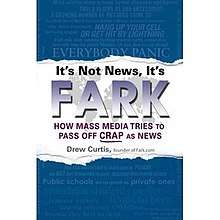It's Not News, It's FARK
It's Not News, It's Fark: How Mass Media Tries to Pass Off Crap as News is the first book by Fark.com founder Drew Curtis.[1] It is a critical look at the Mass Media industry and the go-to stories used when there is a lack of hard news to report.
 | |
| Author | Drew Curtis |
|---|---|
| Country | United States |
| Language | English |
| Subject | Mass Media |
| Genre | Non-fiction |
| Publisher | Gotham Books |
Publication date | May 2007 |
| Pages | 278 pp |
| ISBN | 978-1-59240-366-0 |
| OCLC | 226975395 |
Background
Curtis' site Fark.com was one of the 100 largest English speaking sites receiving over 2,000 submissions a day and over 4 million unique visitors per month,[2] often from the news sources themselves.[3][4] It is generally seen as the destination for strange news stories.[5][6] In the introduction to his book, Curtis noted that running Fark caused him to notice specific patterns within the mass media.[1]
Overview
The book is divided into eight sections, each dealing with a different pattern exhibited by the media industry. Within each section are several specific news stories exemplifying that pattern. At the end of each example, Curtis also lists humorous comments from the original Fark.com discussion thread which covered the news story. The topics are:
- Media Fearmongering contains news stories used to scare the audience. Examples are terrorists attacking, the San Andreas Fault, and the Avian Flu.
- Unpaid Placement Masquerading as Actual Article is about news stories which, whether intentionally or not, advertise a product or organization. An example is an article indicating that 90 percent of the ocean's large fish are extinct—an unconfirmed statistic written by an author promoting a book about damage to the environment.
- Headline Contradicted by Actual Article are news stories which have misleading or contradictory headlines that are the opposite of what is implied by the article. An example is an article run by the Detroit Free Press titled "Asian Vehicles Rank Low in Survey" which later contained the statistic that 29 of the 31 cars that earned a top reliability rating were Japanese.
- Equal Time for Nutjobs is about articles published just to give an opposite side to a story, even if that opposite side has been proven false. Examples include 9/11 Truthers, as well as the anti-vaccination movement.
- The Out-of-Context Celebrity Comment relates to articles which give a disproportionate amount of attention to a comment made by a celebrity, like Brad Pitt's position on stem cell research or the Dixie Chicks' position on the Iraq War.
- Seasonal Articles focuses on recurring articles published the same time every year. An example is AAA reports related to increases in traffic during the Christmas holidays.
- Media Fatigue refers to stories examined and exhausted past their relevance. Examples would include the September 11 attacks and the Janet Jackson Super Bowl XXXVIII halftime show controversy.
- Lesser Media Space Fillers are non-categorical articles which consistently reappear. Examples include the coverage of missing white women and hurricanes.
Reviews and press
The book peaked at #12 on Amazon.com's non-fiction bestseller list.[7] It was reviewed positively by Stephen King, Dave Barry, and Chez Pazienza—a former CNN producer.[8][9] Despite its success, Slate.com reviewer Jack Shafer noted that it received "scant attention" from the mainstream press, noting that the Tucson Citizen was the largest American newspaper to review it.[10] Shafer implied that the book's criticism of mainstream media and acerbic tone may have been responsible.[10] However, the book was more widely recognized in broadcasting, with profiles in NPR, Fox News, and G4TV.[11][12] The book was later released in paperback.[13]
External links
References
- Curtis, Drew (2007). It's Not News, It's Fark: How Mass Media Tries to Pass Off Crap as News. Gotham Books. ISBN 978-1-59240-366-0.
- Interview w/ Drew Curtis
- Fark.com: Lynn Cullen Show
- Takahashi, Dean. "Takahashi: Three who had the right idea at the right time." San Jose Mercury News. January 2, 2008. Retrieved on January 14, 2008.
- Alexa.com rank for Fark 1,933
- Smiley Pete: What the Fark?
- Bio: Drew Curtis for Leigh Speakers Bureau
- Cover of It's Not News, It's Fark UK edition
- Fark.com INNIF page
- Shafer, Jack (October 4, 2007). "Fark Founder Flattens Fourth Estate". Slate.com. Retrieved 2008-06-06. "For all its insight, Curtis' book has gotten scant attention from the mainstream press."
- "Fark.com: Making Money Off of Goofy News". NPR. May 7, 2007. Retrieved 2008-06-06.
- G4TV w/ Drew Curtis
- Amazon: It's Not News, It's Fark: How Mass Media Tries to Pass Off Crap As News (Paperback) Publisher: Gotham; Reprint edition (May 29, 2008)